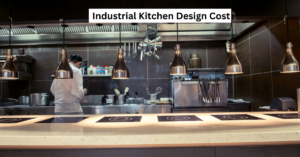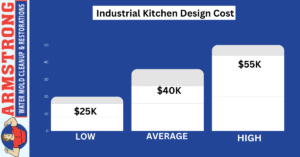
Thinking about setting up an industrial kitchen? Get ready for a cost breakdown that will save you from unexpected expenses!
Industrial kitchen designs for homes have become increasingly popular, offering a stylish yet functional approach to modern living. This design style draws inspiration from commercial kitchens, blending raw materials, open spaces, and utilitarian aesthetics. Whether you’re looking to install industrial kitchen cabinets or create a modern industrial kitchen, this guide will help you achieve an industrial look kitchen effortlessly.
Cost breakdown of Industrial Kitchen Design
| Cost Category | Estimated Cost |
| Lowest Cost | $25,000 |
| Highest Cost | $55,000 |
| Average Cost | $40,000 |

How to Achieve the Perfect Industrial Kitchen Design for Your Home
| Layout Type | Estimated Cost per Sq Ft in Florida |
| Open Layout | $250 – $300 |
| Island Layout | $250 – $300 |
| Zone Layout | $250 – $300 |
| Galley Layout | $250 – $300 |
| Assembly Line Layout | $250 – $300 |
Introduction
Designing an industrial kitchen requires careful planning, and understanding the industrial kitchen design cost is essential. Every detail affects the cost of industrial kitchen design from equipment to layout. Whether you’re starting fresh or revamping an existing space, the industrial kitchen renovation cost varies based on materials, appliances, and compliance requirements. But how much does an industrial kitchen cost overall? Let’s break it down with a detailed pricing guide.
Understanding the Industrial Kitchen Design Cost
The industrial kitchen design cost depends on several factors, including space size, material choices, and equipment selection. The cost of industrial kitchen design typically ranges from $50,000 for a small setup to $500,000+ for a high-end facility. If you’re considering upgrades, the industrial kitchen renovation cost can vary based on existing infrastructure. So, how much does an industrial kitchen cost? The answer lies in your specific needs and business goals. Proper budgeting ensures efficiency and long-term success in your culinary operations.
Industrial kitchen layouts
Designing an industrial kitchen necessitates thoughtful evaluation of varying layout options to enhance workflow, efficiency, and safety. Below are concise explanations of five typical industrial kitchen layouts
Open Layouts
Open kitchen layouts merge the cooking area with the dining area, enabling customers to witness food preparation. This layout promotes transparency and interaction between chefs and patrons, enriching the dining experience. However, it requires strict cleanliness and noise control to sustain a pleasant environment.
Island Layouts
The island layout showcases a central workstation—frequently outfitted with cooking or preparation tools—encircled by auxiliary stations. This arrangement encourages effective communication among staff and provides sufficient space for several chefs to operate concurrently. It is particularly appropriate for kitchens with extensive floor areas.
Zone Layouts
Also referred to as the “sectional” layout, the zone layout segments the kitchen into distinct zones dedicated to specific functions, including preparation, cooking, baking, and sanitation. This specialization reduces cross-contamination and streamlines workflows, making it particularly suitable for establishments with varied menus.
Galley Layouts
The galley layout is characterized by two parallel workstations with a central pathway, optimizing space utilization. This configuration is beneficial for compact or narrow kitchens, enabling a simplified workflow where chefs can easily navigate between stations.
Assembly Line Layouts
In an assembly line layout, kitchen stations are organized sequentially based on the preparation process, ranging from raw ingredient handling to final plating. This configuration is optimal for establishments with high-volume, standardized menus, such as fast-food restaurants, as it guarantees a uniform and swift production flow.
What Defines an Industrial Kitchen?
An industrial kitchen design for home is characterized by a combination of raw materials, neutral color schemes, and high-functionality elements. Some defining features include:
Exposed Brick and Concrete: Adds texture and an unfinished, rugged appeal.
Metal Accents: Stainless steel or black metal elements are commonly used for a factory-like feel.
Industrial Kitchen Cabinets: These are typically made from reclaimed wood, metal, or a mix of both.
Open Shelving: Instead of traditional cabinetry, open shelving adds to the aesthetic while keeping everything accessible.
Functional Lighting: Pendant lights with exposed bulbs or metal shades are staples of an industrial design.
Choosing the Right Industrial Kitchen Cabinets
One of the most important elements in achieving an industrial look kitchen is selecting the right cabinets. Industrial kitchen cabinets are designed to be both stylish and durable, often featuring metal frames, wooden panels, and minimalist hardware. Here are some popular choices:
Metal and Wood Combination
A mix of reclaimed wood and steel provides a striking contrast while maintaining the industrial aesthetic. This style is ideal for homeowners looking for both warmth and durability.
All-Metal Cabinets
Stainless steel cabinets offer a sleek and modern industrial kitchen feel, similar to those found in professional restaurant kitchens. They are easy to clean and incredibly durable.
Distressed or Reclaimed Wood Cabinets
For those who want a vintage industrial look, distressed or reclaimed wood cabinets are perfect. They add character and a sense of history to the space.
Matte Black or Dark Grey Cabinets
Dark-hued cabinets, often paired with metal hardware, enhance the industrial vibe while keeping the kitchen looking sophisticated.
Incorporating the Industrial Look in Your Kitchen
To create a modern industrial kitchen, consider incorporating these essential elements:
Exposed Elements and Raw Materials
An industrial look kitchen relies heavily on raw materials like exposed brick walls, concrete countertops, and visible ductwork. These features create an authentic factory-inspired aesthetic.
Open Layout and Functional Design
An open-concept kitchen is a staple in industrial kitchen designs for homes. Removing unnecessary walls or barriers helps achieve a spacious and airy feel, making the space more inviting and efficient.
Industrial Lighting
Lighting is a crucial component of a modern industrial kitchen. Consider using pendant lights with black or metal finishes, Edison bulbs, or track lighting to complete the look.
Choosing the Right Flooring
Concrete flooring, distressed wood, or large-format tiles work best for an industrial aesthetic. They provide durability and maintain the raw appeal of the space.
Complementing the Design with the Right Accessories
To further enhance the industrial look kitchen cabinets and overall decor, consider these elements:
Metal Bar Stools and Chairs: Opt for stools with a metal base and wooden seats to keep the theme consistent.
Minimalist Hardware: Avoid ornate cabinet handles; instead, go for matte black or brushed steel options.
Neutral Color Palette: Shades of gray, black, and white, complemented by natural wood tones, maintain the industrial feel.
Vintage or Antique Elements: Adding vintage decor like old signage, clocks, or rustic containers can elevate the space.
Industrial Kitchen Design Ideas for Small Spaces
Even in smaller kitchens, an industrial design can work beautifully with some smart design choices:
Compact Industrial Kitchen Cabinets: Opt for metal-framed cabinets with glass inserts to keep the space feeling open.
Wall-Mounted Storage: Instead of bulky cabinets, use open shelving and hanging racks to maximize space.
Mirrored or Glossy Surfaces: While the industrial look leans towards matte finishes, incorporating some reflective surfaces can help make a small kitchen appear larger.
- Smart Lighting Choices: Installing under-cabinet LED lighting or pendant lights over an island helps brighten up a small kitchen.
Maintaining an Industrial Kitchen
An industrial look kitchen is not only about aesthetics but also about functionality. Here’s how to keep it in top condition:
Regularly Clean Metal Surfaces: Stainless steel and metal elements require periodic polishing to prevent rust or stains.
Seal Concrete Countertops: If you choose concrete countertops, sealing them is essential to avoid stains and water damage.
Maintain Wood Elements: Industrial kitchen cabinets made of wood should be treated with protective coatings to maintain durability.
Factors that impact the cost of different industrial kitchen layouts
| Factor | Impact on Cost |
| Kitchen Size | Larger kitchens require more materials, labor, and equipment, increasing overall costs. |
| Layout Complexity | More complex layouts (e.g., Zone or Assembly Line) require additional planning, specialized equipment, and installation, leading to higher expenses. |
| Equipment & Appliances | High-end or commercial-grade appliances significantly raise costs, while energy-efficient options may have higher upfront costs but lower long-term expenses. |
| Ventilation System | Industrial kitchens need high-quality ventilation systems, which can be expensive depending on the kitchen size and local building codes. |
| Plumbing & Electrical Work | Extensive plumbing for sinks, dishwashers, and water lines, as well as complex electrical setups, can increase costs, especially in older buildings requiring upgrades. |
| Flooring & Wall Materials | Durable, heat-resistant, and easy-to-clean materials (e.g., stainless steel, tile, epoxy flooring) can be costly but necessary for safety and maintenance. |
| Labor & Installation | Skilled labor for specialized kitchen installations, including carpentry, electrical, and plumbing work, impacts the final cost. |
| Permits & Compliance | Meeting local health and safety regulations, obtaining necessary permits, and ensuring fire safety compliance can add to expenses. |
| Customization & Design | Custom-built industrial kitchen cabinets, unique storage solutions, and tailored design elements increase costs compared to standard installations. |
| Energy Efficiency & Sustainability | Investing in energy-efficient appliances, LED lighting, and water-saving fixtures may have a higher initial cost but result in long-term savings. |
Is an industrial kitchen worth the investment? Let’s break down the costs!
Industrial Kitchen Design Cost vs other types of kitchen design services
Kitchen Design Style | Average Cost |
$20,000- $50,000 | |
$20,000 – $45,000 | |
$15,000 – $40,000 | |
$20,000 – $50,000 | |
$25,000 – $55,000 | |
$15,000 – $35,000 | |
$18,000 – $40,000 | |
$15,000 – $30,000 | |
$20,000 – $45,000 | |
$10,000 – $25,000 | |
$7,500 – $29,000 | |
$15,000 – $40,000 | |
$20,000 – $50,000 | |
$25,000 – $60,000 | |
$30,000 – $70,000 | |
$25,000 – $60,000 | |
$30,000 – $75,000 | |
$24,000 – $75,000 |
Final consideration

Designing an industrial kitchen is a significant investment, but with the right planning, it can be both cost-effective and highly functional. From industrial kitchen cabinets to modern industrial kitchen layouts, the total cost depends on factors like materials, appliances, ventilation, and customization. Whether you’re designing an industrial kitchen for home or a large-scale commercial setup, understanding these cost elements ensures you make informed decisions.
To get a customized cost estimate based on your specific kitchen needs, consult with industrial kitchen design experts today! Schedule a free consultation here and start your journey toward an efficient, stylish, and functional industrial kitchen.
FAQs
Between $25,000 and $55,000 for home kitchens; commercial setups can go beyond $500,000.
Factors like size, layout, materials, equipment, ventilation, labor, and permits impact the total cost.
Yes, materials like stainless steel and reclaimed wood can increase costs.
Use budget-friendly materials, refurbish existing equipment, and choose energy-efficient appliances.
Yes! Industrial kitchens are durable, functional, and stylish, making them a long-term asset.
